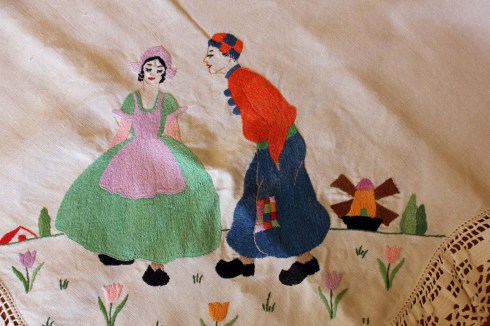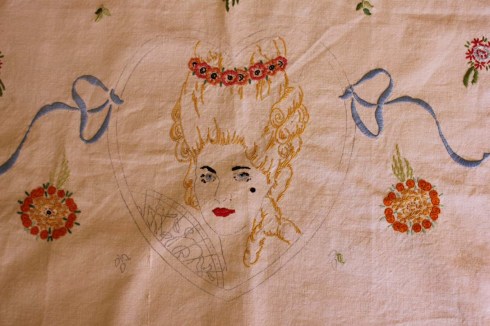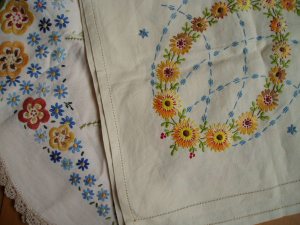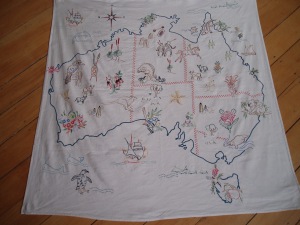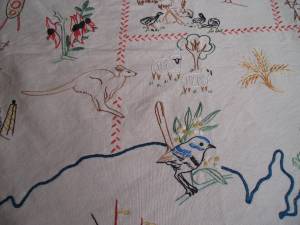You are currently browsing the tag archive for the ‘New Zealand’ tag.
My latest TradeMe find came in the post a couple of days ago, and it’s a goodie – a linen tablecloth with a deep crocheted edging. In each corner, each embroidered in a different colour scheme using blocks of satin stitch, is a Dutch couple, complete with clogs, bonnet, tulips and a windmill in the distance. The woman’s eyes are modestly downcast; the pairs of figures might even be dancing.
I particularly like embroidery that features people (and animals, but I’ll come to that another time). I love the carefree expression on the face of this lass (somehow the right word!) on a swing.
Like many embroidered women, she holds flowers – but unlike many others, she has a relatively contemporary look about her, with shortish hair and what appears to be a ’50s dress.
Many embroidered women sport crinolines and bonnets. Below, one woman gives flowers to another (a prelude to a 19th-century lesbian romance, I expect).
This wildly glamorous woman with her haughty expression and red nails is on an apron, probably from the 1930s – it’s somehow ironic that the apron hasn’t been cared for, and is spattered with paint.
Is this unfinished (but beautifully embroidered) apron, below, meant to be Marie Antoinette? I love it that the embroiderer has given her a beauty spot while leaving other parts uncompleted. These highly decorated aprons were typically intended for special occasions, not for everyday use.
While I appreciate elegant work (most of it from kits), I’ve also got a particular fondness for more homely, awkward pieces, which may have been designed by the maker. This girl (again on an apron) seems to be gazing just off-screen with an expression of horror as she clutches her bouquet. The tight rows of chain stitch used for her skin and dress also make her look slightly… well… diseased. This apron has no neck strap, and would have been worn pinned to the wearer’s dress or blouse.
And I love this perky madam – a woman who knows her own mind, I reckon. Look at those eyes. Her flowers are particularly colourful.
But one of my favourite pieces is this unassuming little dressing-table mat featuring two Māori wāhine. No flowers here, but flax bushes or bulrushes/raupō. Both women are barefoot, wearing cloaks, and with feathers in their hair.
This woman, below, carries her baby in the traditional style, on her back, tucked under her cloak – the only embroidered depiction of motherhood that I’ve come across anywhere. It’s interesting that representations of parenting or heterosexuality (of men, in fact!) are almost entirely absent from these embroideries, most of which depict a rather dreamlike, female-only world of elegant dresses, flowers and hair done in ringlets (!) – a fantasy of escape from daily drudgery? Men and babies appear only on the Dutch-themed tablecloth and Māori-themed mat. Perhaps the ‘exotic’ nature of other ethnicities (I’m assuming a Pākehā embroiderer, which may or may not be right) added a little glamour, or at least distance, to what would otherwise have seemed mundane or everyday.
There’s an embarrassment of riches for lovers of vintage textiles, fabrics and crafts in Wellington in June.
First up is the annual symposium of the Costume and Textile Association of New Zealand, on 12 and 13 June at the NewDowse in Lower Hutt. Delightfully titled ‘Hanging by a Thread’, the symposium will be looking at tales of textile disaster and survival. Sessions include University of Georgia professor Katalin Medvedev on Cambodian women’s weaving, Lindie Ward from Sydney’s Powerhouse Museum on the Australian Dress Register, and Linda Tyler from the Centre for New Zealand Art Research and Discovery on John Buchanan‘s calico pattern designs. I’m also rather taken by ‘A nice gay jersey: masculinity and the knitting pattern’, by Hawke’s Bay Museum director Douglas Lloyd Jenkins – remember all those male knitwear models with their jutting jaws, clutching fishing rods?
The complete programme can be found here, and the registration form here.
Also at the NewDowse on Sat 12 June from 10am-3pm, the wonderful Craft 2.0 fair will no doubt once again fill the museum with dozens of innovative contemporary crafters and their fans/customers. Time for some early Christmas shopping, perhaps?
Then, the weekend after, the Fabric-a-brac fabric sale is at St Anne’s church hall in Emmett Street, Newtown, from 9am-12pm on Sat 19 June. I haven’t made it to a Fabric-a-brac yet, but love the idea of people selling groovy old fabrics. If I keep buying them at my current rate, I’ll soon need to have a Fabric-a-brac stall to get rid of them again…
It’s also World Wide Knit in Public Day – or days, rather, from 12 to 20 June, when brave souls are encouraged to get together and – what else – knit in public. The Wellington knit-in-public event is on Sat 12 June, at 2pm at the Offbeat Cafe in the Left Bank. It’s great when knitters come out of the closet – I was delighted to see a woman knitting on the bus the other morning.
I’ve also just discovered the inspired nuttiness of Outdoor Knit – check out the ‘It’s a Tree!’ project.
It’s almost enough to make you forget that it’s winter. Well, hmm, maybe.
I think it began when I discovered TradeMe. Suddenly, a source of endless happy time-wasting, and 1960s children’s card games, and TEAL ashtrays with stylised tiki, and old hotel plates with fern logos, and swizzle sticks in the shape of taiaha or pineapples. And then, an ageing handmade felt golly with a snazzy red and yellow outfit and a sad and bewildered expression on his stitched face, and two tablecloths embroidered with beautiful and complicated floral designs. They were too lovely to put away; I pinned them to the wall.
Then I found a long silky kimono painstakingly embroidered with a version of the Willow Pattern, and some dressing-table mats embellished with hollyhocks, and crinoline ladies, and even one with a Māori wahine in a cloak, a little baby on her back and a flax bush beside her. Someone else was selling her grandmother’s collection of souvenir headscarves – silky beautiful things boasting of trips to New Guinea, Australia and the ‘Fiji Islands’ (all hibiscus and outrigger canoes and afro’d fishermen, that one). The souvenir hankies were even better, with their clumsy hand lettering and awkward, brightly-coloured pictures of parrots and marlin and poi dancers and Māori warriors.
I was hooked. I fought with another buyer over a tablecloth wonderfully embroidered with a pictorial map of New Zealand, the country’s outlines dotted with the ubiquitous warriors and pohutukawa and kiwi. I told myself that $75 was my limit, but I kept bidding, my heart pounding, to $120 before I gave up. I wondered if my opponent was Rosemary McLeod, famous for her collections of vintage textile crafts; I muttered and grumbled to think that some other bastard had nabbed my tablecloth for a mere dollar more. But then someone listed an Australian version (kookaburras, wombats, boomerangs, crocodiles) and I got it for a mere $30.
I’m not really a historian, though I like imagining the past, especially its domestic, unsung details. Perhaps more importantly, if I’m honest, I like things that are beautiful, and things that are funny. I love skilled handiwork, but I also love things that are awkward, a little clumsy, a little kitschy or politically incorrect. I enjoy pieces that mix Māori and Pākehā traditions or imagery, sometimes quirkily, hopefully without hurting anyone’s sensibilities or sensitivities. Really, when it comes down to it, I just like stuff.


